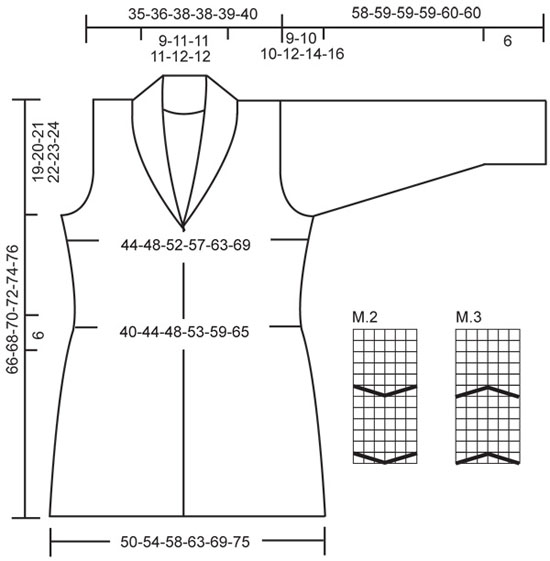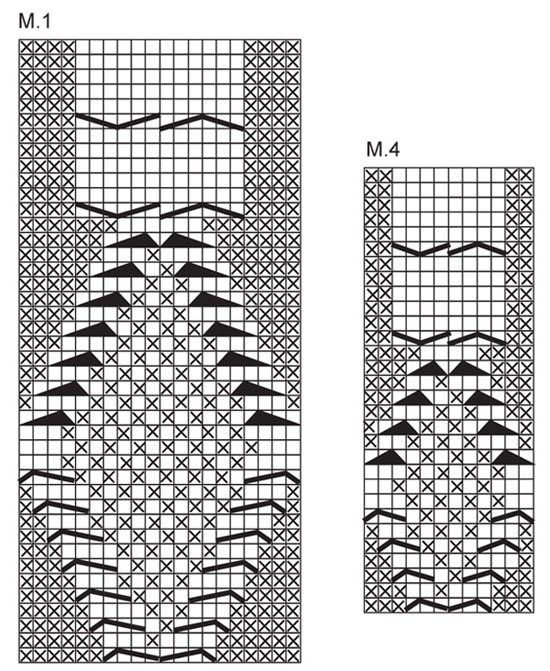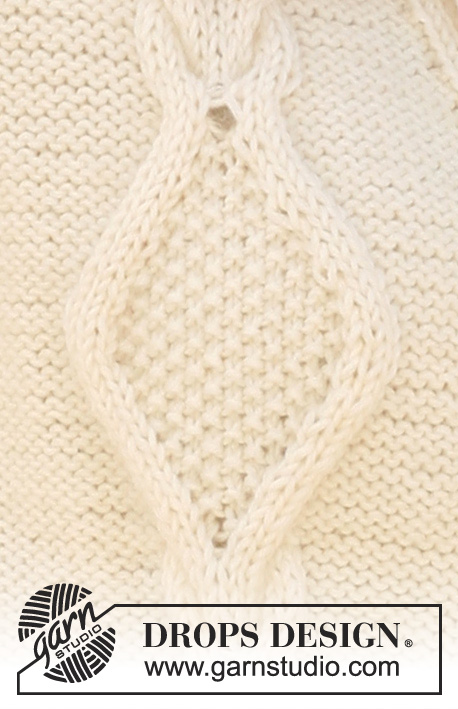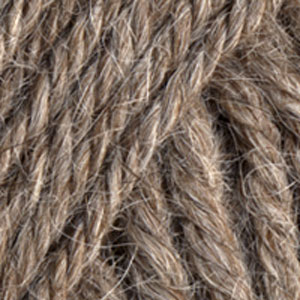Melissa |
|||||||||||||||||||||||||||||||||||||||||||
|
|
|||||||||||||||||||||||||||||||||||||||||||
Knitted DROPS jacket with cables and collar in ”Classic Alpaca” or "Puna" and ”Kid-Silk”. Size S - XXXL.
DROPS 115-8 |
|||||||||||||||||||||||||||||||||||||||||||
|
FRONT BAND: Front band is worked as follows from mid front, as seen from RS: 7 SEED STS - see below-, K1, P1, K1, P1, K1, P1 and K1. DECREASING TIP: Make all dec from RS. Dec 2 sts at the side. Beg 1 st before st with marker, K/P3 tog (acc to Seed st pattern). This 1 st is now st with marker. PATTERN: See diagram M.1 to M.4. Diagrams show the pattern from RS. SEED ST: Row 1: * P1, K1 *, repeat from *-*. Row 2: P over K and K over P. Repeat row 2. INCREASING TIP: Make all inc from RS. Inc 2 sts at the side by making 1 YO each side of st with marker. On next row work YO into back of loop to avoid a hole. Incorporate inc sts in Seed st. BUTTONHOLES: Make buttonholes on right front band. 1 buttonhole = bind off the 5th front band st from mid front and cast on 1 new st on return row. Make buttonholes when piece measures: SIZE S: 10, 18, 26, 34 and 42 cm / 4", 7", 10¼", 13⅜" and 16½". SIZE M: 11, 19, 27, 35 and 43 cm / 4⅜", 7½", 10⅝", 13¾" and 17" SIZE L: 9, 16, 23, 30, 37 and 44 cm / 3½", 6¼", 9", 11¾", 14½" and 17¼". SIZE XL: 10, 17, 24, 31, 38 and 45 cm / 4", 6¾", 9½", 12¼", 15" and 17¾". SIZE XXL: 11, 18, 25, 32, 39 and 46 cm / 4⅜", 7", 9¾", 12½", 15¼" and 18". SIZE XXXL: 7, 15, 23, 31, 39 and 48 cm / 2¾", 6", 9", 12¼", 15¼" and 19". -------------------------------------------------------- -------------------------------------------------------- BODY PIECE: Worked back and forth on circular needle from mid front. Cast on 230-238-250-270-290-310 sts (includes 14 front band sts each side towards mid front) on circular needle size 4.5 mm / US 7 with 1 thread of each quality (Classic Alpaca + Kid-Silk or Puna + Kid-Silk). P 1 row from WS on all sts and continue in rib as follows: 14 FRONT BAND sts – see above, * K2, P2 *, repeat from *-* until 16 sts remain, K2 and 14 FRONT BAND sts. Continue like this until piece measures 3 cm / 1⅛". Change to circular needle size 5 mm / US 8 and now continue as follows from RS: 14 Front band sts, P 9-10-10-10-12-12, M.1 (= 20 sts), P 5-5-6-11-11-14, P2 tog, M.2 (= 6 sts), 15-17-21-21-27-31 SEED STS - see above - M.3 (= 6 sts), P 6-6-7-12-12-15, M.1, P 4-4-4-4-5-5, K3, 10-12-12-12-14-14 SEED STS, K3, P 4-4-4-4-5-5, M.1, P 6-6-7-12-12-15, M.2, 15-17-21-21-27-31 SEED STS, M.3, P2 tog, P 5-5-6-11-11-14, M.1, P 9-10-10-10-12-12 and 14 Front band sts = 2 dec sts = 228-236-248-268-288-308 sts on needle. Insert 1 marker in st 63-65-68-73-78-83 and 1 marker in st 166-172-181-196-211-226 (= the sides, back piece = 102-106-112-122-132-142 sts). Continue with K over K, P over P, pattern over pattern and Seed st over Seed st. When piece measures 6 cm / 2⅜" dec 2 sts each side – See DECREASING TIP = 224-232-244-264-284-304 sts. Repeat the dec when piece measures 9 cm / 3½" and 11 cm / 4⅜" = 216-224-236-256-276-296 sts. When piece measures 14 cm / 5½" work next row from RS as follows: 14 Front band sts, P2 tog, P 7-8-8-8-10-10, M.1, P 6-6-7-12-12-15, M.2, 9-11-15-15-21-25 SEED STS (marker sits in the middle of these sts), M.3, P 6-6-7-12-12-15, M.1, P2 tog, P 2-2-2-2-3-3, K3, 10-12-12-12-14-14 SEED STS, K3, P 2-2-2-2-3-3, P2 tog, M.1, P 6-6-7-12-12-15, M.2, 9-11-15-15-21-25 SEED STS (marker sits in the middle of these sts), M.3, P 6-6-7-12-12-15, M.1, P 7-8-8-8-10-10, P2 tog and 14 Front band sts = 4 dec sts = 212-220-232-252-272-292 sts on needle. Continue with K over K, P over P, pattern over pattern and Seed st over Seed st. When piece measures 16 cm / 6¼" dec 2 sts each side – See DECREASING TIP = 208-216-228-248-268-288 sts. Repeat the dec when piece measures 19 cm / 7½" and 21 cm / 8¼" = 200-208-220-240-260-280 sts. When piece measures 24 cm / 9½" work next row from RS as follows: 14 Front band sts, P2 tog, P 6-7-7-7-9-9, M.1, P 6-6-7-12-12-15, M.2, 3-5-9-9-15-19 SEED STS (marker sits in the middle of these sts), M.3, P 6-6-7-12-12-15, M.1, P2 tog, P 1-1-1-1-2-2, K3, 10-12-12-12-14-14 SEED STS, K3, P 1-1-1-1-2-2, P2 tog, M.1, P 6-6-7-12-12-15, M.2, 3-5-9-9-15-19 SEED STS (marker sits in the middle of these sts), M.3, P 6-6-7-12-12-15, M.1, P 6-7-7-7-9-9, P2 tog and 14 Front band sts = 4 dec sts = 196-204-216-236-256-276 sts on needle. Continue with K over K, P over P, pattern over pattern and Seed st over Seed st. When piece measures 26 cm / 10¼" dec 2 sts each side – See DECREASING TIP = 192-200-212-232-252-272 sts. When piece measures 32 cm / 12½" inc 2 sts each side – See INCREASING TIP – on every 3.5-4-4-4.5-5-5 cm / 1¼"-1½"-1½"-1¾"-2"-2" a total of 4 times = 208-216-228-248-268-288 sts. Continue with K over K, P over P, pattern over pattern and Seed st over Seed st. When piece measures 44-45-46-47-48-49 cm / 17¾"-18"-18½"-19"-19¼" dec for neck and inc for collar as follows: Dec 1 st inside 14 front band sts (from RS) by P2 tog, repeat on every 4-3.5-4-4-3.5-3.5 cm / 1½"-1¼"-1½"-1½"-1¼"-1¼" a total of 5-6-6-6-7-7 times. AT THE SAME TIME with every dec for neck inc 1 st (from RS) for collar. Inc 1 st inside 7 front band sts by making 1 YO between Seed st and K1 on front band. On next row work YO into back of loop to avoid a hole, then incorporate inc st in the seed st. AT THE SAME TIME when piece measures 47-48-49-50-51-52 cm / 18½"-19"-19¼"-19¾"-20"-20½" bind off 7 sts each side (i.e. 3 sts each side of marker + st with marker) for armhole and complete each piece separately. BACK PIECE: = 86-90-96-106-116-126 sts. Continue with K over K, P over P, pattern over pattern and Seed st over Seed st. AT THE SAME TIME bind off for armhole each side at the beg of every row: 2 sts 3-4-5-7-9-11 times and 1 st 1-0-0-1-1-1 times = 72-74-76-76-78-80 sts. When piece measures 64-66-68-70-72-74 cm / 25¼"-26"-26¾"-27½"-28⅜"-29⅛" bind off the middle 16-18-18-18-20-20 sts for neck and complete each shoulder (= 28-28-29-29-29-30 sts) separately. When piece measures 65-67-69-71-73-75 cm / 25½"-26⅜"-27⅛"-28"-28¾"-29½" dec (from RS) 6 sts evenly on K sts in M.1 = 22-22-23-23-23-24 sts. Work 1 row from WS and loosely bind off remaining sts. Piece measures approx 66-68-70-72-74-76 cm / 26"-26¾"-27½"-28⅜"-29⅛"-30". LEFT FRONT PIECE: = 54-56-59-64-69-74 sts. Continue with K over K, P over P, pattern over pattern and Seed st over Seed st. AT THE SAME TIME continue dec for neck and inc for collar and bind off for armhole at the side as described for back piece. When dec for armhole are complete there are a total of 47-48-49-49-50-51 sts on needle. When dec for neck and inc for collar are complete there are 19-20-20-20-21-21 sts on front band. Continue with K over K, P over P, pattern over pattern and Seed st over Seed st until piece measures 65-67-69-71-73-75 cm / 25½"-26⅜"-27⅛"-28"-28¾"-29½". Now dec (from RS) 6 sts evenly on K sts in M.1 = 41-42-43-43-44-45 sts. Work 1 row from WS. Now loosely bind off 22-22-23-23-23-24 sts from shoulder towards neckline = 19-20-20-20-21-21 front band sts left on needle. Work remaining sts on row. Now work shortened rows on front band sts as follows: * back and forth on the outermost 12-13-13-13-14-14 sts only (= Seed st), back and forth on all sts (= Seed st and 7 sts K1/P1) *, repeat from *-* until collar measures approx 5-6-6-6-7-7 cm / 2"-2⅜"-2⅜"-2⅜"-2¾"-2¾" on the shorter side (measured from shoulder). Bind off. RIGHT FRONT PIECE: Like left front piece, but mirrored. Remember BUTTONHOLES – see above. SLEEVE: Worked in the round on double pointed needles. Cast on 44-44-48-48-48-52 sts on double pointed needles size 4.5 mm / US 7 with 1 thread of each quality (Classic Alpaca + Kid-Silk or Puna + Kid-Silk). K 1 round. Insert a marker at beg of round (= mid under sleeve). Continue in rib K2/ P2. When piece measures approx 6 cm / 2⅜" change to double pointed needles size 5 mm / US 8 and continue as follows: P 20-20-22-22-22-24, K4 and P 20-20-22-22-22-24. When piece measures 7 cm / 2¾" continue as follows: P 16-16-18-18-18-20, M.4 (= 12 sts) and P 16-16-18-18-18-20. When piece measures 9-9-9-8-8-8 cm / 3½"-3½"-3½"-3⅛"-3⅛"-3⅛" inc 2 sts mid under sleeve (= 1 st each side of marker), and repeat on every 4-3.5-3.5-3-2.5-2 cm / 1½"-1¼"-1¼"-1⅛"-⅞"-¾" a total of 10-11-11-13-15-16 times = 64-66-70-74-78-84 sts. Continue until piece measures 49-49-49-47-46-44 cm / 19¼"-19¼"-19¼"-18½"-18"-17¼" (less for the larger sizes because of longer sleeve cap and wider shoulder). Now bind off 6 sts mid under sleeve (i.e. 3 sts each side of marker) and complete piece back and forth on needle. Bind off for sleeve cap each side at the beg of every row: 2 sts 3 times and 1 st 2-3-2-5-7-9 times, then 2 sts each side until piece measures 57-58-58-58-59-59 cm / 22½"-22¾"-22¾"-22¾"-23¼"-23¼". Now bind off 4 sts at beg of row from RS, AT THE SAME TIME dec 4 sts evenly on K sts in M.4, bind off 4 sts at beg of next row from WS and bind off remaining sts. Sleeve measures approx 58-59-59-59-60-60 cm / 22¾"-23¼"-23¼"-23¼"-23⅝"-23⅝". ASSEMBLY: Sew shoulder seams (make sure cables from front and back pieces meet on shoulder). Set in sleeves. Sew collar tog mid back and sew to neck on back piece. Sew on buttons. |
|||||||||||||||||||||||||||||||||||||||||||
Diagram explanations |
|||||||||||||||||||||||||||||||||||||||||||
|
|||||||||||||||||||||||||||||||||||||||||||

|
|||||||||||||||||||||||||||||||||||||||||||

|
|||||||||||||||||||||||||||||||||||||||||||
|
Have you made this or any other of our designs? Tag your pictures in social media with #dropsdesign so we can see them! Do you need help with this pattern?You'll find tutorial videos, a Comments/Questions area and more by visiting the pattern on garnstudio.com. © 1982-2024 DROPS Design A/S. We reserve all rights. This document, including all its sub-sections, has copyrights. Read more about what you can do with our patterns at the bottom of each pattern on our site. |
|||||||||||||||||||||||||||||||||||||||||||





































































Comments / Questions (35)
Ho capito ....ho letto meglio! Grazie, vittoria
26.01.2024 - 23:18Buongiorno,sto avviando il lavoro di questo modello . Non ho capito se il bordo davanti è composto da 7 maglie per ciascun bordo o da 14 maglie ( per ciascun bordo). Nella prima pagina alla spiegazione " Bordo davanti" è scritto 7 ,nella spiegazione del corpo è scritto 14 . Vi ringrazio del chiarimento. Vittoria
26.01.2024 - 22:48Further to my previous question re shawl collor shapings K1, Collar Inc, remaining 6 seed sts, 7 rib sts , Collar Dec (p2tog ). so Increases are done 1 st in from start of row and decreases are done after the 14 front band sts??
10.11.2023 - 15:58DROPS Design answered:
Dear Carol, yes, that's correct. K1, inc, 6 seed sts, 7 rib sts and p2tog. Happy knitting!
12.11.2023 - 23:41Dec for neck & inc for collar: place of inc & dec 7 seed sts, inc sts, 7 other sts then dec Inc's are done in the middle of the Front Band and the dec's are done in the purl sts between Front Band and M.1 ? Is this correct?
09.11.2023 - 22:04DROPS Design answered:
Dear Mrs McMillan, the increases and the decreases for neckline are worked as follows: at the beg of the row work the 1st stitch and increase for collar, continue working front band sts as before then P2 tog on right front piece; starting when the front band sts + the sts increased for collar remain, P2 tog then work the front band sts as before. Happy knitting!
10.11.2023 - 09:52I need help with the Front Band Stitches Row 1: 7 Seed sts (P1, K1, P1, K1, P1, K1, P1) then K1, P1, K1, P1, K1, P1, K1. Why not say 14 Seed sts? Row 2: P1, K1, P1, K1, P1, K1, P1 then 7 Seed sts (K1, P1, K1, P1, K1, P1, K1). Why not say 14 Seed sts? Is this correct?
09.11.2023 - 21:58DROPS Design answered:
Dear Mrs Mc Millan, seen from RS work the right front band stitches as follows: 7 sts in seed stitch, 7 sts rib (K1, P1) ending with K1. And the left front band stitches will be worked, seen from RS: 7 sts rib (K1, P1) ending with K1, 7 sts seed stitch. Happy knitting!
10.11.2023 - 09:32Can I use Muskat for this pattern? Single thread?
28.06.2023 - 15:47DROPS Design answered:
Dear Marcia, you can use Muskat but you should use also 1 strand Kid-Silk as this jacket is worked with 2 strands held together. Happy knitting!
28.06.2023 - 16:30Bonjour, Je souhaite faire ce modèle avec une seule laine la Drops Alaska, laine qui se tricote en 5. Puis-je faire ceci ? Dans l'affirmative, combien dois-je acheter de pelotes de laine.
15.11.2020 - 16:17DROPS Design answered:
Bonjour Bibi, DROPS Alaska peut se tricoter aussi avec 17 mailles pour 10 cm de large, mais rappelez-vous que vous n'aurez pas la même texture car ces laines ont une composition différente - retrouvez plus d'infos sur les alternatives ici - votre magasin saura vous aider si besoin, même par mail ou téléphone. Bon tricot!
16.11.2020 - 09:07Merci Drops design, j’adore ce modèle comme tous vos modèles d’ailleurs et j’ai hâte de l’avoir fini. C’est vrai que j’etais septique de reprendre la torsade au départ et de tricoter les mailles endroits en mailles envers. Je pensais que ça se verrait et que le rendu ne serait pas joli mais pas du tout. Ça ne se voit pas et le rendu est parfait. Merci encore. Marianne
30.01.2018 - 19:34Bonjour, je ne comprends pas comment reprendre la torsade M1 au début après les 42 premiers rands du motif?? Pourriez vous m’aider. Merci
29.01.2018 - 23:20DROPS Design answered:
Bonjour Mme Richin, reprenez simplement au 1er rang de M.1 en commençant par 6 m env, les 2 torsades et 6 m env. Bon tricot!
30.01.2018 - 08:47How many yards were in Alpaca Classic? I would like to make this sweater. Thank you for your help.
28.01.2016 - 00:12DROPS Design answered:
Dear Mrs Adsitt, please click for more informations about Classic Alpaca and here to find an alternative same group and calculate new amount of yarn. Happy knitting!
28.01.2016 - 13:28